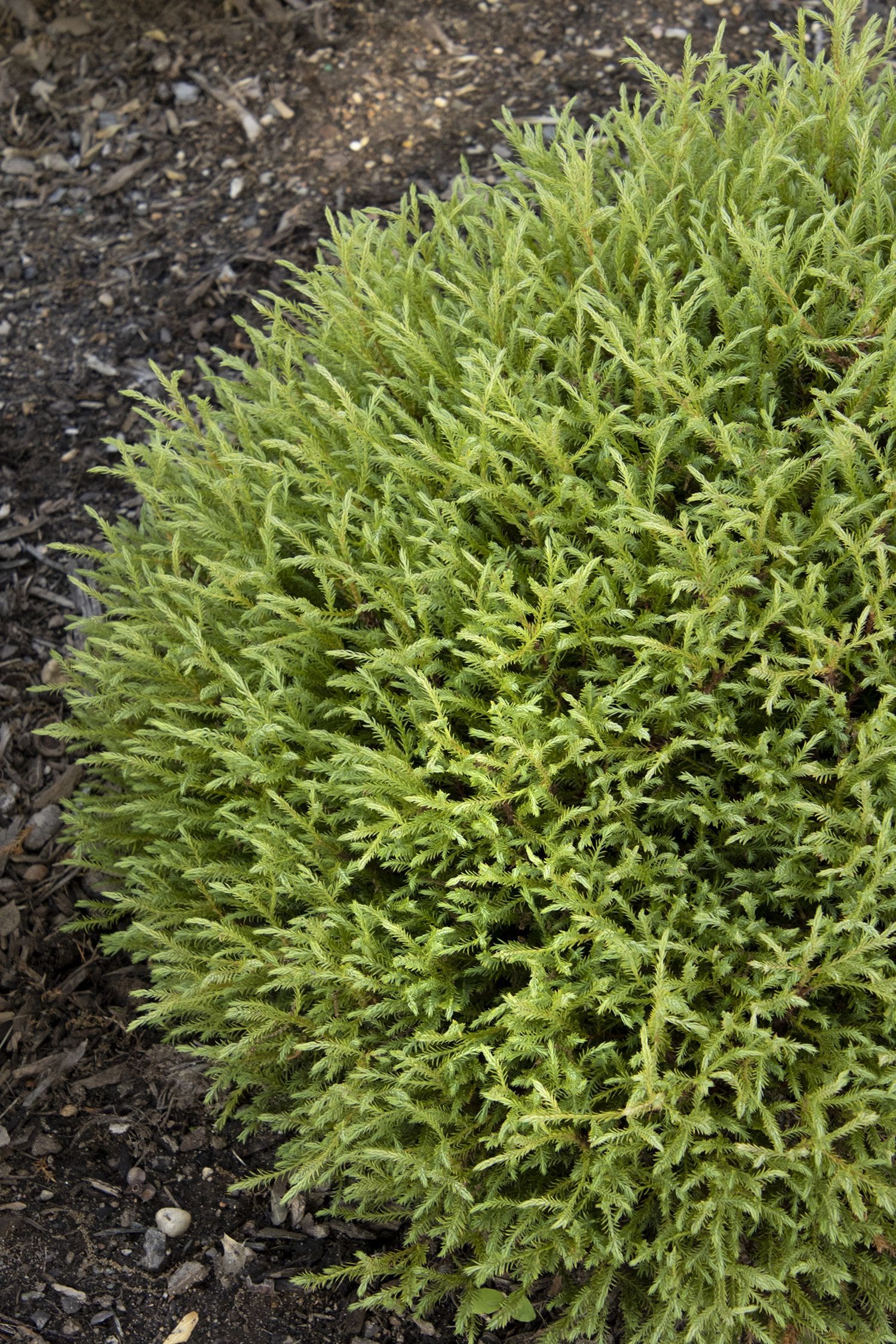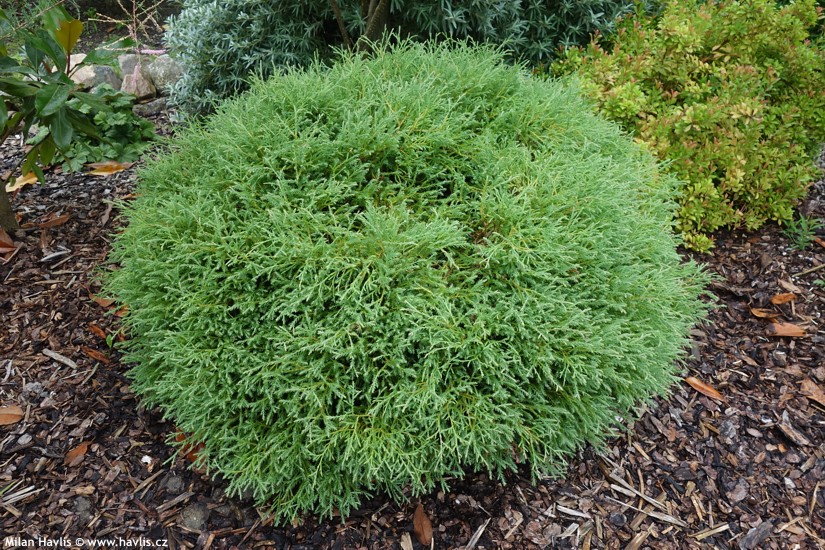
Mr. Bowling Ball Arborvitae Pahl's Market Apple Valley, MN
More About Mr. Bowling Ball® Cedar. Thrives in enriched, evenly moist, loamy, well-drained soils; dislikes dry conditions. Provide afternoon shade in hot summer regions and protect from harsh winds. Water deeply, regularly during the first growing season to establish an extensive root system. Fertilize in early spring.

Mr. Bowling Ball Arborvitae 1 Gallon Shrub Deer Resistant Shrubs
Mr. Bowling Ball Arborvitae Height: 3 feet Spread: 3 feet Sunlight: Hardiness Zone: 4a Other Names: Eastern White Cedar Description: This tiny shrub just demands to be loved by all gardeners, with very unusual threadlike sage-green foli

Mr. Bowling Ball® Globe Cedar Thuja occidentalis 'Bobazam' Yard
History and Origins of the Mr. Bowling Ball™ Arborvitae. Mr. Bowling Ball™ Arborvitae is a selected form of the American arborvitae, Thuja occidentalis, also called white cedar. This tree grows wild across all the north-east, and right up into Canada, and it can be seen growing along the edges of forests and in wet-lands.

Thuja occidentalis 'Bobazam' Mr. Bowling Ball® Dwarf Arborvitae Kigi
Place Mr. Bowling Ball in full sun and make sure to keep the soil moist and well-drained to maintain its simply-soft texture. Low-maintenance in nature, Mr. Bowling Ball needs no special pruning; however, sheering before the onset of new growth can help increase longevity. This adaptable dwarf Thuja grows up to 2-3 feet tall and wide, making it.

Photo of the entire plant of Northern White Cedar (Thuja occidentalis
This evergreen shrub with finely textured sage green foliage forms a perfect, 3-foot-diameter, slow-growing globe, hence its name, Mr. Bowling Ball®. It is synonymous with 'Linesville'. Noteworthy Characteristics This plant requires no pruning or shearing to maintain its shape. It is useful in foundation plantings, borders, and containers.

Garden Elements 2 Gallon Mr. Bowling Ball Cedar (Thuja occidentalis
Mr. Bowling Ball Arborvitae makes a fine choice for the outdoor landscape, but it is also well-suited for use in outdoor pots and containers. It can be used either as 'filler' or as a 'thriller' in the 'spiller-thriller-filler' container combination, depending on the height and form of the other plants used in the container planting.

Cedar, Mr. Bowling Ball Eastern Coville's Greenhouses
Bobozam arborvitae grows so close to the ground that the foliage mostly covers this classic bark of the false cedar family. Tiny cones appear in late summer but are of little ornamental interest. Growing a Mr. Bowling Ball Shrub. The Mr. Bowling Ball shrub is very tolerant of a range of conditions. It prefers full sun but can also grow in.

Thuja occidentalis 'Mr BOWLING BALL' Havlis.cz
Mr. Bowling Ball Arborvitae makes a fine choice for the outdoor landscape, but it is also well-suited for use in outdoor pots and containers. It can be used either as 'filler' or as a 'thriller' in the 'spiller-thriller-filler' container combination, depending on the height and form of the other plants used in the container planting.

GREEN PLUS Mr. Bowling Ball Cedar 2gal Pot 829525003811 RONA
Answer 1 of 4: This is a weird question, but I'm wondering if any of the bowling alleys around Milan have a pro shop where my husband can buy a bowling ball. It's a crazy souvenir, but he is a bowling coach and really wants to get a European release ball when we.

Thuja occidentalis Mr Bowling Ball White cedar 'Mr Bowling Ball
Description. Thuja occidentalis 'Mr Bowling Ball' is a dwarf variety of White Cedar which tends to be more groundcover than others in its genus. Requires very little maintenance, boasting evergreen, threadlike, sage-green foliage. High impact compact shrub used as a low hedge or dotted through borders. Height & Spread: 70cm (28").

PlantFiles Pictures Thuja, American Arborvitae, Eastern White Cedar
Mr. Bowling Ball Arborvitae makes a fine choice for the outdoor landscape, but it is also well-suited for use in outdoor pots and containers. It can be used either as 'filler' or as a 'thriller' in the 'spiller-thriller-filler' container combination, depending on the height and form of the other plants used in the container planting.

Mr. Bowling Ball Arborvitae Stock Photo Image of ball, cedar 161013470
It resembles a bowling ball, hence its name, and is prized for its soft, fine-textured foliage. Native: Thuja occidentalis is native to North America. It is predominantly found in the northeastern United States and southeastern Canada. This species naturally occurs in wet forests, swamps, and along lake shores, thriving in cool, moist, well.

Photo of the entire plant of Northern White Cedar (Thuja occidentalis
Mr. Bowling Ball® Arborvitae (Thuja occidentalis 'Bobazam') is a dwarf, rounded cultivar of the species. Also known as White Cedars, these pretty shrubs are native to the upper northeast United States. This hardy plant has all the wonderful characteristics of an Arborvitae. But it grows in a unique, compact, perfectly globe-shaped form.

Mr Bowling Ball Arborvitae stock image. Image of cedar 230059797
MR. BOWLING BALL CEDAR. Lacy, deep green foliage with excellent year-round color. A naturally rounded dwarf habit with dense evergreen foliage. Useful for low hedges, foundation plantings, and in areas where space is limited. Location: Full Sun; Ht: 24 in. - 30 in. Sp: 24 in. - 30 in. Hardy to -40 C; Sharing.

Thuja occidentalis 'Mr BOWLING BALL' Havlis.cz
Mr. Bowling Ball ® Arborvitae. The silvery green, dwarf Thuja occidentalis Mr. Bowling Ball ® ('Bobazam') looks like an oversized bowling ball, except for its fine, almost lacy, texture. Actually, it is a reliable, mid-size, spherical bush that has many uses in the landscape. A Lake County Nursery 'Zam' selection from Linesville, Pennsylvania, it is hardy, durable and adaptable to.

PlantFiles Pictures White Cedar, Eastern Arborvitae, American
2Gallon (7.5L) Mr Bowling Ball Globe Cedar (Thuja) Evergreen Shrub A perfect round ball of finely textured, soft to the touch, sage green foliage. Needles are distinctly different from other cedars, almost feather-like. Requires no pruning to maintain its shape!